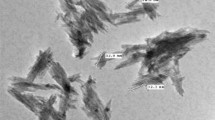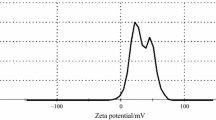Abstract
Nanofluids, having 1–100 nm size particles in any base fluid are promising fluid for heat transfer intensification due to their enhanced thermal conductivity as compared with the base fluid. The forced convection of nanofluids is the major practical application in heat transfer equipments. In this study, heat transfer enhancements at constant wall heat flux under laminar flow conditions were investigated. Nanofluids of different volume fractions (1, 2 and 4 %) of copper (I) oxide nanoparticles in deionized water were prepared using two step technique under mechanical mixing and ultrasonication. The results were investigated by increasing the Reynolds number of the nanofluids at constant heat flux. The trends of Nusselt number variation with dimensionless length (X/D) and Reynolds numbers were studied. It was observed that heat transfer coefficient increases with increases particles volume concentration and Reynolds number. The maximum enhancement in heat transfer coefficient of 61 % was observed with 4 % particle volume concentration at Reynolds number (Re ~ 605).














Similar content being viewed by others
Abbreviations
- Cp :
-
Specific heat capacity [kJ/(kg K)]
- D:
-
Diameter (of test section pipe) (m)
- f :
-
Friction factor of (nano)fluid in test section
- h:
-
Average heat transfer coefficient in test section [W/(m2 K)]
- hx :
-
Local heat transfer coefficient [W/(m2 K)]
- k:
-
Thermal conductivity [W/(m K)]
- L:
-
Length of heated test section (m)
- lj :
-
Length of particular section j of test section (m)
- Q:
-
Mass flow rate through test rig (kg/s)
- Nu:
-
Average Nusselt number in test section
- Nux :
-
Local Nusselt number
- Gz:
-
Graetz number
- f:
-
Fluid
- w:
-
Wall
- A:
-
Area (m2)
- p:
-
Pressure (Pa)
- P:
-
Electric power (W)
- Pr:
-
Prandtl number of fluid in test section
- q″:
-
Heat flux density from test section pipe to water (W/m2)
- Q′:
-
Heat flux from test section pipe to water (W)
- Re:
-
Reynolds number
- T:
-
Temperature (°C)
- Tin :
-
Fluid temperature at inlet to test section (°C)
- Tout :
-
Fluid temperature at outlet of test section (°C)
- u:
-
Fluid velocity in test section (m/s)
- Q:
-
Volume flow rate (m3/s)
- X:
-
Distance from start of heating in test section to place j∗ (Dimensionless)
- Δ:
-
Difference
- μ :
-
Dynamic viscosity [kg/(m s)]
- ρ:
-
Density (kg/m3)
- Φ :
-
Volume fraction (%)
- NPs:
-
Nanoparticles
- HTC:
-
Heat transfer coefficient
- TC:
-
Thermocouple
- MWCNT:
-
Multi-wall carbon nanotube
- DWCNT:
-
Double wall carbon nanotube
- p:
-
Particle
- nf:
-
Nanofluids
- bf:
-
Base fluids
References
Choi SUS (1995) Enhancing thermal conductivity of fluids with nanoparticles. In: Siginer DA, Wang HP (eds) Developments and applications of non-newtonian flows, FED-V.231/MD-V.66. ASME, New York, pp 99–105
Choi SUS, Zhang ZG, Keblinski P (2004) Nanofluids. In: Nalwa HS (ed) Encyclopedia of nanoscience and nanotechnology, vol 6. American Scientific, Los Angeles, Calif, USA, pp 757–737
Eastman JA, Phillpot SR, Choi SUS, Keblinski P (2004) Thermal transport in nanofluids. Ann Rev Mat Res 34:219–246
Özerinç S, Kakaç S, Yazıcıoğlu AG (2010) Enhanced thermal conductivity of nanofluids: a state-of-the-art review. Microfluid Nanofluid 8(2):145–170
Ding Y, Alias H, Wen D, Williams RA (2006) Heat transfer of aqueous suspensions of carbon nanotubes (CNT nanofluids). Int J Heat Mass Transf 49:240–250
Zhu HT, Zhang CY, Tang YM, Wang JX (2007) Novel synthesis and thermal conductivity of CuO nanofluid. J Phys Chem 111(4):1646–1650
Hong T, Yang H, Choi CJ (2005) Study of the enhanced thermal conductivity of Fe nanofluids. J Appl Phys 97(6):064311–064314
Beck M, Yuan Y, Warrier P, Teja A (2009) The effect of particle size on the thermal conductivity of alumina nanofluids. J Nanopart Res 11(5):1129–1136
Wang X, Choi SUS, Xu X (1999) Thermal conductivity of nanoparticle-fluid mixture. J Thermophys Heat Transf 13(4):474–480
Czarnetzki W, Roetzel W (1995) Temperature oscillation techniques for simultaneous measurement of thermal diffusivity and conductivity. Int J Thermophys 16(2):413–422
Ju YS, Kim J, Hung M (2008) Experimental study of heat conduction in aqueous suspensions of aluminum oxide nanoparticles. J Heat Transf 130(9):092403–092406
Putnam SA, Cahill DG, Braun PV, Ge Z, Shimmin RG (2006) Thermal conductivity of nanoparticle suspensions. J Appl Phys 99(8):084308
Paul G, Chopkar M, Manna I, Das PK (2010) Techniques for measuring the thermal conductivity of nanofluids: a review. Renew Sustain Energy Rev 14:1913–1924
Lee S, Choi SUS (1996) Application of metallic nanoparticle suspensions in advanced cooling systems. In: International mechanical engineering congress and exhibition, Atlanta, USA
Xuan Y, Li Q (2003) Investigation on convective heat transfer and flow features of nanofluids. J Heat Transf 125:151–155
Wen D, Ding Y (2004) Experimental investigation into convective heat transfer of nanofluids at the entrance region under laminar flow conditions. Int J Heat Mass Transf 47(24):5181
Heris SZ, Esfahany MN, Etemad SGH (2007) Experimental investigation of convective heat transfer of Al2O3/water nanofluid in circular tube. J Heat Fluid Flow 8:203–210. doi:10.1016/j.ijheatfluidflow.2006.05.001
Zhou DW (2004) Heat transfer enhancement of copper nanofluid with acoustic cavitation. Int J Heat Mass Transf 47:3109–3117
Chien HT, Tsai CI, Chen PH, Chen PY (2003) Improvement on thermal performance of a disk-shaped miniature heat pipe with nanofluid. In: IEEE, Shanghai, China, p 389
Tsai CY, Chien HT, Ding PP, Chan B, Luh TY, Chen PH (2004) Effect of structural character of gold nanoparticles in nanofluid on heat pipe thermal performance. Mater Lett 58:1461–1465
Ding Y, Alias H, Wen D, Williams RA (2005) Heat transfer of aqueous suspensions of carbon nanotubes (CNT nanofluids). Int J Heat Mass Transf 49(1–2):240–250
Pak BC, Cho YI (1998) Hydrodynamic and heat transfer study of dispersed fluids with submicron metallic oxide particles. Exp Heat Transf 11(2):151–170
Yang Y, Zhang ZG, Grulke EA, Anderson WB, Wu G (2005) Heat transfer properties of nanoparticle-in-fluid dispersions (nanofluids) in laminar flow. Int J Heat Mass Transf 48(6):1107–1116
Putra N, Roetzel W, Das SK (2003) Natural convection of nano-fluids. Heat Mass Transf 39(8–9):775–784
Wen D, Ding Y (2006) Formulation of nanofluids for natural convective heat transfer applications. Int J Heat Fluid Flow 26(6):855–864
Hefei Quantum Quelle Nano Science and Technology Co., LTD, China. www.quantum-nano.com/en/
Batchelor GK (1977) The effect of Brownian motion on the bulk stress in a suspension of spherical particles. J Fluid Mech 83:97–117
Buongiorno J, Venerus DC, Prabhat N (2009) A benchmark study on the thermal conductivity of nanofluids. J. Appl Phys 106:094312
Incropera FP, DeWitt DP (1996) Fundamentals of heat and mass transfer. Wiley, New York
Shah RK, London AL (1978) Supplement 1 to Advances in heat transfer. Academic Press, New York
Shah RK, Bhatti MS (1987) Handbook of single-phase convective heat transfer (chapter 3). Wiley, New York
Chen WK (1993) Linear networks and systems (book style). Wadsworth, Belmont, pp 123–135
Taylor JR (1997) An introduction to error analysis. University Science Books, Sausalito
Murshed S, Leong K, Yang C (2008) Thermophysical and electro kinetic properties of nanofluids—a critical review. Appl Therm Eng 28(17–18):2109–2125
Bejan A (2004) Convection heat transfer. Wiley, New Jersey
Estellé P, Halelfadl S, Maré T (2015) Thermal conductivity of CNT water based nanofluids: experimental trends and models overview. J Therm Eng 1(2):381–390
Ting H-H, Hou S-S (2015) Investigation of laminar convective heat transfer Al2O3-water nanofluids flowing through a squarcross-section duct with a constant heat flux. Materials 8:5321–5335
Yang C, Li W, Nakayama A (2013) Convective heat transfer of nanofluids in a concentric annulus. Int J Therm Sci 71:249–257
Acknowledgments
The authors express immense thanks to Department of Chemical Engineering, University of Engineering and Technology, Lahore, Pakistan, for providing test facility and analysis instruments. We are also thankful to Mr. Muhammad Shabbir, Institute of Environmental Engineering and Research, UET, Lahore for providing deionized water.
Author information
Authors and Affiliations
Corresponding author
Rights and permissions
About this article
Cite this article
Umer, A., Naveed, S. & Ramzan, N. Experimental study of laminar forced convective heat transfer of deionized water based copper (I) oxide nanofluids in a tube with constant wall heat flux. Heat Mass Transfer 52, 2015–2025 (2016). https://doi.org/10.1007/s00231-015-1713-1
Received:
Accepted:
Published:
Issue Date:
DOI: https://doi.org/10.1007/s00231-015-1713-1




